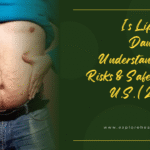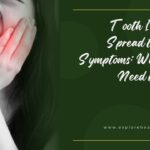Introduction: What Is Bronchiolectasis and Why Should You Care?
If you’ve recently come across the term bronchiolectasis on a CT scan report or in a doctor’s office, you might feel confused or even alarmed. It’s not a word most people hear often, yet it can play a significant role in your lung health—especially if you suffer from frequent respiratory infections or chronic cough.
In simple terms, bronchiolectasis refers to the abnormal widening (dilation) of the small airways in the lungs called bronchioles. While it’s similar to bronchiectasis—which affects larger airways—bronchiolectasis involves even smaller, more delicate tubes.
Understanding what this condition means, what causes it, and how it’s treated can help you or a loved one breathe easier. With respiratory conditions becoming more common in the U.S. due to pollution, infections, and long-COVID symptoms, awareness is more critical than ever.
What Is Bronchiolectasis?
🔍 Definition
Bronchiolectasis is a structural lung abnormality where the bronchioles become permanently dilated and sometimes distorted. These small airways are responsible for channeling air to the alveoli, where oxygen exchange occurs. When they are damaged and widened, they can’t effectively clear mucus, leading to infections and inflammation.
This condition can occur:
- As a result of chronic or repeated infections
- From immune system issues
- In connection with other lung diseases like COPD or interstitial lung disease
Although it’s less common than bronchiectasis, bronchiolectasis is increasingly being detected with high-resolution CT (HRCT) scans, especially as part of evaluations for chronic cough or unexplained lung problems.
What Causes Bronchiolectasis?
Multiple underlying health issues can lead to bronchiolectasis, including:
Chronic Infections
- Repeated episodes of pneumonia
- Tuberculosis (TB) damage
- Viral infections that cause long-term inflammation
Immune Disorders
- Primary immunodeficiencies, which reduce your body’s ability to fight infections
- HIV/AIDS
Environmental & Occupational Exposure
- Long-term exposure to pollutants, dust, or chemical fumes
- Smoking and vaping-related lung injury
Autoimmune and Inflammatory Conditions
- Rheumatoid arthritis
- Sarcoidosis
According to the National Heart, Lung, and Blood Institute (NHLBI), chronic respiratory diseases are on the rise in the U.S., partly due to aging populations and persistent environmental exposures.
Symptoms of Bronchiolectasis
Bronchiolectasis can sometimes be silent, especially in early stages. But over time, symptoms may include:
- Chronic, productive cough (with phlegm)
- Recurrent respiratory infections
- Wheezing or shortness of breath
- Chest discomfort
- Fatigue or low energy
- Crackling lung sounds (heard with a stethoscope)
If you’ve had several lung infections in the past year, it’s worth asking your doctor whether you should be evaluated for bronchiolectasis or other structural airway conditions.
How Is Bronchiolectasis Diagnosed?
📋 Common Diagnostic Steps:
- Clinical History & Physical Exam
- Doctors ask about recurrent infections, family history, or autoimmune diseases.
- Doctors ask about recurrent infections, family history, or autoimmune diseases.
- Pulmonary Function Tests (PFTs)
- These measure how well your lungs are working and how much air you can exhale.
- These measure how well your lungs are working and how much air you can exhale.
- High-Resolution CT Scan
- The gold standard for identifying bronchiolectasis. It shows dilated bronchioles often described as “tree-in-bud” patterns, a telltale radiological sign.
- The gold standard for identifying bronchiolectasis. It shows dilated bronchioles often described as “tree-in-bud” patterns, a telltale radiological sign.
- Blood Tests and Immunology Workup
- Used to rule out underlying causes like immune deficiencies or autoimmune conditions.
- Used to rule out underlying causes like immune deficiencies or autoimmune conditions.
- Sputum Culture
- Checks for bacteria, fungi, or atypical organisms in mucus.
- Checks for bacteria, fungi, or atypical organisms in mucus.
Bronchiolectasis vs. Bronchiectasis: What’s the Difference?
While both involve airway dilation, the main difference lies in the size of the affected airways:
| Feature | Bronchiectasis | Bronchiolectasis |
| Affected Airways | Larger bronchi (2mm–5mm) | Smaller bronchioles (<2mm) |
| Severity of Symptoms | Often more pronounced | Can be subtle or asymptomatic |
| Radiologic Appearance | Thick-walled, dilated airways | Fine tree-in-bud or tubular patterns |
Radiopaedia.org provides imaging examples and detailed radiology definitions for bronchiolectasis and related conditions.
U.S. Trends and Concerns (2024–2025)
🧬 Post-COVID Lung Damage
Emerging research from late 2024 shows that long-COVID may be linked to the development of subtle lung changes, including bronchiolectasis. A growing number of patients recovering from COVID-19 are being monitored for airway abnormalities due to persistent cough and imaging changes.
🏭 Urban Air Quality
The American Lung Association notes that over 35% of U.S. residents live in areas with unhealthy air quality, which can worsen inflammation in the lungs and may contribute to airway changes over time.
🧓 Aging Population
As the population ages, chronic respiratory conditions are becoming more prevalent. People over 65 are more likely to have structural airway changes, often discovered during evaluations for cough or breathlessness.
Treatment Options for Bronchiolectasis
There’s no one-size-fits-all approach to bronchiolectasis. Treatment is tailored to the cause, severity, and symptoms.
🚑 Medical Management:
- Antibiotics for infections (sometimes long-term for recurring cases)
- Mucolytics to thin mucus
- Bronchodilators for airflow improvement
- Inhaled corticosteroids for inflammation control
🧘♂️ Airway Clearance Techniques:
- Chest physiotherapy or percussion vests
- Postural drainage (specific positions to drain mucus)
- Oscillatory positive expiratory pressure (PEP) devices like Acapella or Aerobika
💊 Immunotherapy:
- For patients with underlying immune conditions, immunoglobulin therapy may reduce infections.
🚫 Lifestyle Adjustments:
- Quit smoking and avoid secondhand smoke
- Get annual flu and pneumonia vaccines
- Monitor indoor air quality using HEPA filters
The U.S. Environmental Protection Agency (EPA) offers guidelines for improving home air quality to protect sensitive lungs.
When to See a Specialist
If you’ve been diagnosed with bronchiolectasis—or suspect you might have it—it’s a good idea to consult a pulmonologist (lung specialist). You may also need help from:
- Immunologists (for immune-related causes)
- Rheumatologists (for autoimmune diseases)
- Infectious disease specialists
Early diagnosis and multidisciplinary care can prevent long-term lung damage and reduce hospitalizations.
FAQs About Bronchiolectasis
Q: Is bronchiolectasis reversible?
A: Unfortunately, no. Once bronchioles are damaged and dilated, they don’t return to normal. However, proper treatment can help manage symptoms and prevent progression.
Q: Is it contagious?
A: The condition itself is not contagious, but underlying infections can be, depending on the cause.
Q: Can it lead to serious complications?
A: Yes. If left untreated, it can lead to recurrent pneumonia, respiratory failure, or the spread of infection to other parts of the body.
Conclusion: Don’t Ignore the Signs of Bronchiolectasis
While bronchiolectasis may not be as well-known as asthma or bronchitis, it’s a meaningful diagnosis—especially if you’re dealing with chronic lung issues. As imaging technology improves and awareness grows in the U.S., more people are being diagnosed earlier, giving them a better shot at maintaining quality of life.
If you’ve been told you have bronchiolectasis or are experiencing persistent respiratory symptoms, speak with your doctor about next steps. With the right care plan, many people manage the condition effectively and live full, active live.
Whether you’re managing long-COVID symptoms or experiencing recurring lung infections, don’t ignore your lungs. If you’ve been diagnosed with bronchiolectasis—or suspect something’s not right—schedule an appointment with a pulmonary specialist and advocate for a full evaluation.
About ExploreHealthToday.com
ExploreHealthToday.com was created to be a one-stop resource where readers can find up-to-date, well-researched articles on a variety of health topics. From nutrition and wellness to lifestyle and mental health, we strive to provide reliable information to help you make informed decisions about your well-being.
We believe that good health starts with good information, and our mission is to empower our readers with knowledge they can trust.
Visit us at ExploreHealthToday.com to learn more.





